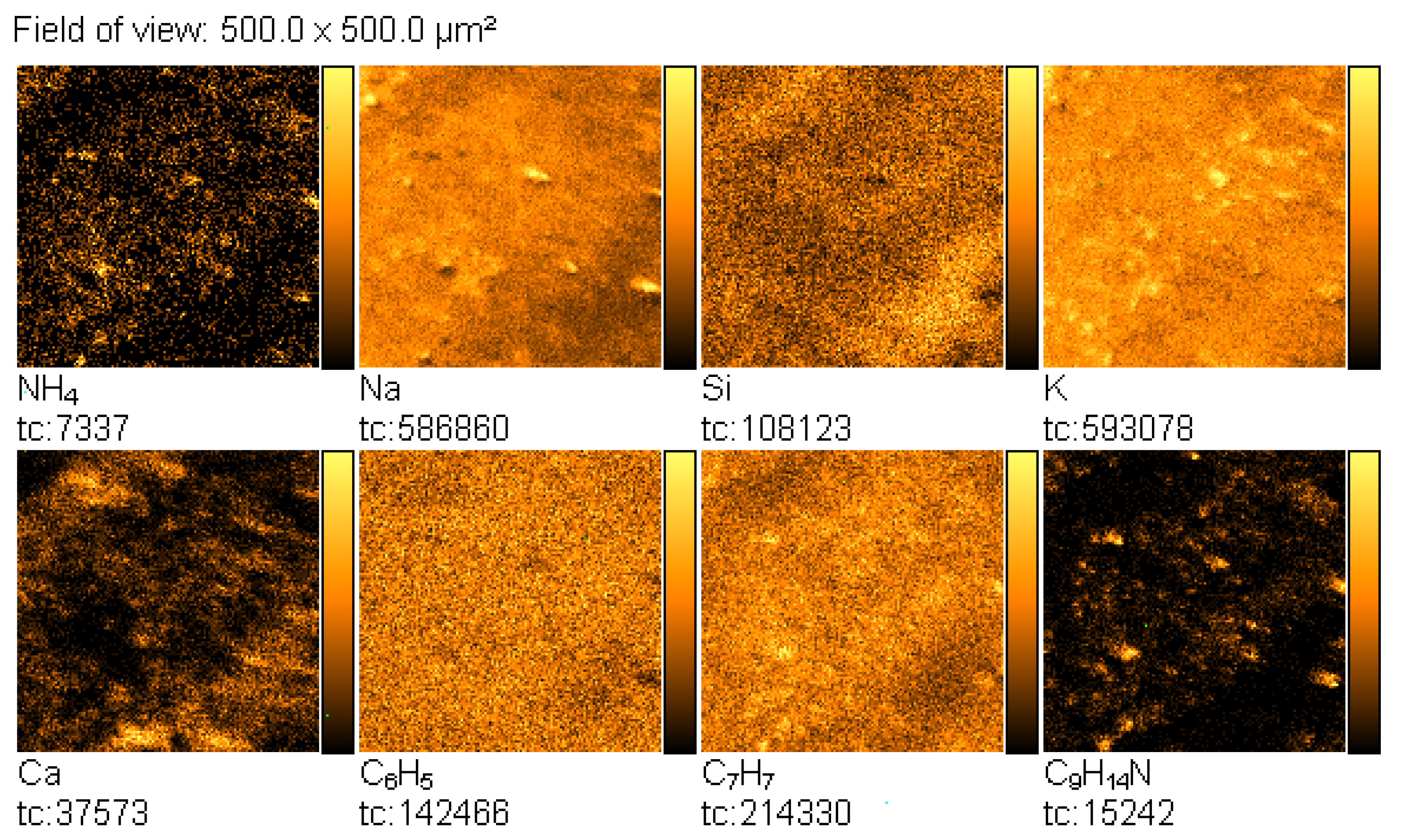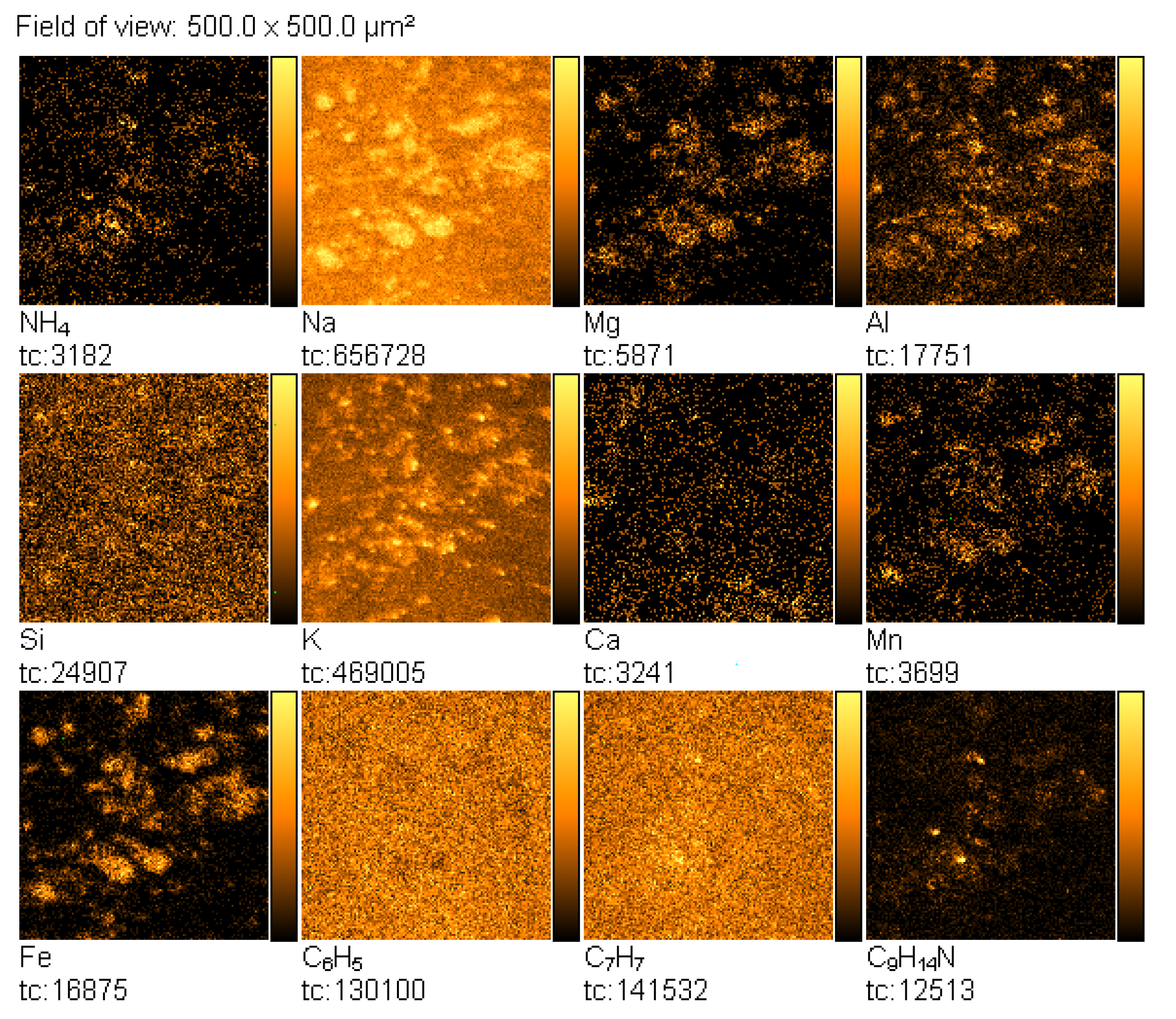Visualisation of Amphetamine Contamination in Fingerprints Using TOF-SIMS Technique
Abstract
:1. Introduction
2. Materials and Methods
2.1. Preparation of Samples
2.2. Instrumentation and Instrumental Parameters
3. Results and Discussion
4. Conclusions
Author Contributions
Funding
Institutional Review Board Statement
Informed Consent Statement
Data Availability Statement
Conflicts of Interest
References
- Margot, P. History. Fingerprint Sciences. In Encyclopedia of Forensic Sciences, 1st ed.; Siegel, J., Saukko, P., Eds.; Academic Press: Oxford, UK, 2000; p. 1054. [Google Scholar]
- Hamilton, I. Fingerprints. In Encyclopedia of Forensic Sciences, 1st ed.; Siegel, J., Saukko, P., Eds.; Academic Press: Oxford, UK, 2000; p. 346. [Google Scholar]
- Mozayani, A.; Noziglia, C. The Forensic Laboratory Handbook. Procedures and Practice; Humana Press Inc.: Totowa, NJ, USA, 2006. [Google Scholar]
- Muramoto, S.; Forbes, T.P.; van Asten, A.C.; Gillen, G. Test sample for the spatially resolved quantification of illicit drugs on fingerprints using imaging mass spectrometry. Anal. Chem. 2015, 87, 5444–5450. [Google Scholar] [CrossRef]
- Girod, A.; Ramotowski, R.; Weyermann, C. Composition of fingermark residue: A qualitative and quantitative review. Forensic Sci. Int. 2012, 223, 10–24. [Google Scholar] [CrossRef] [PubMed] [Green Version]
- Hazarika, P.; Jickells, S.M.; Russell, D.A. Rapid detection of drug metabolites in latent fingermarks. Analyst 2009, 134, 93–96. [Google Scholar] [CrossRef] [PubMed]
- Bailey, M.J.; Bradshaw, R.; Francese, S.; Salter, T.L.; Costa, C.; Ismail, M.; Webb, P.R.; Bosman, I.; Wolff, K.; de Puit, M. Rapid Detection of Cocaine, Benzoylecgonine and Methylecgonine in Fingerprints Using Surface Mass Spectrometry. Analyst 2015, 140, 6254–6259. [Google Scholar] [CrossRef] [PubMed] [Green Version]
- Hazarika, P.; Jickells, S.M.; Russell, D.A.; Wolff, K. Multiplexed Detection of Metabolites of Narcotic Drugs from a Single Latent Fingermark. Anal. Chem. 2010, 82, 9150. [Google Scholar] [CrossRef]
- Benton, M.; Chua, M.J.; Gu, F.; Rowell, F.; Ma, J. Environmental nicotine contamination in latent fingermarks from smoker contacts and passive smoking. Forensic Sci. Int. 2010, 200, 28–34. [Google Scholar] [CrossRef]
- Bleay, S.M.; Bailey, M.J.; Croxton, R.S.; Francese, S. The forensic exploitation of fingermark chemistry: A review. WIREs Forensic Sci. 2020, 3, e1403. [Google Scholar] [CrossRef]
- Wei, Q.; Zhang, M.; Ogorevcb, B.; Zhang, X. Recent advances in the chemical imaging of human fingermarks (a review). Analyst 2016, 141, 6172–6189. [Google Scholar] [CrossRef] [Green Version]
- Bailey, M.J.; Ismail, M.; Bleay, S.; Bright, N.; Levin, E.M.; Cohen, Y.; Geller, B.; Everson, D.; Costa, C.; Webb, R.P.; et al. Enhanced imaging of developed fingerprints using mass spectrometry imaging. Analyst 2013, 138, 6246–6250. [Google Scholar] [CrossRef] [Green Version]
- Bradshaw, R.; Denison, N.; Francese, S. Implementation of MALDI MS profiling and imaging methods for the analysis of real crime scene fingermarks. Analyst 2017, 142, 1581–1590. [Google Scholar] [CrossRef] [Green Version]
- Lauzonand, N.; Chaurand, P. Detection of exogenous substances in latent fingermarks by silver-assisted LDI imaging MS: Perspectives in forensic sciences. Analyst 2018, 143, 3586–3594. [Google Scholar]
- Bleay, S.M.; Croxton, R.S.; de Puit, M. Fingerprint Development Techniques. Theory & Application; John Wiley & Sons: Hoboken, NJ, USA, 2018. [Google Scholar]
- Szynkowska, M.I.; Parczewski, A.; Szajdak, K.; Rogowski, J. Examination of gunshot residues transfer using ToF-SIMS. Surf. Interface Anal. 2012, 45, 596. [Google Scholar] [CrossRef]
- Kara, I.; Lisesivdin, S.B.; Kasap, M.; Er, E.; Uzek, U. The Relationship Between the Surface Morphology and Chemical Composition of Gunshot Residue Particles. J. Forensic Sci. 2015, 60, 1030. [Google Scholar] [CrossRef] [PubMed]
- Szynkowska, M.I.; Czerski, K.; Rogowski, J.; Paryjczak, T.; Parczewski, A. Detection of exogenous contaminants of fingerprints using ToF-SIMS. Surf. Interface Anal. 2010, 42, 393. [Google Scholar] [CrossRef]
- Pluhácek, T.; Švidrnocha, M.; Maier, V.; Havlícek, V.; Lemr, K. Laser ablation inductively coupled plasma mass spectrometry imaging: A personal identification based on a gunshot residue analysis on latent fingerprints. Anal. Chim. Acta 2018, 1030, 25–32. [Google Scholar] [CrossRef]
- Bailey, M.J.; Randall, E.C.; Costa, C.; Salter, T.L.; Race, A.M.; de Puit, M.; Koeberg, M.; Baumertg, M.; Bunch, J. Analysis of urine, oral fluid and fingerprints by liquid extraction surface analysis coupled to high resolution MS and MS/MS—opportunities for forensic and biomedical science. Anal. Method 2016, 8, 3373–3382. [Google Scholar] [CrossRef] [Green Version]
- Szynkowska, M.I.; Czerski, K.; Rogowski, J.; Paryjczak, T.; Parczewski, A. ToF-SIMS application in the visualization and analysis of fingerprints after contact with amphetamine drugs. Forensic Sci. Int. 2009, 184, 24. [Google Scholar] [CrossRef]
- West, M.J.; Went, M. The spectroscopic detection of drugs of abuse in fingerprints after development with powders and recovery with adhesive lifters. Spectrochim. Acta Part A Mol. Biomol. Spectrosc. 2009, 71, 1984–1988. [Google Scholar] [CrossRef]
- De Oliveira Penido, C.A.F.; Tavares Pacheco, M.T.; Lednev, I.K.; Silveira, L., Jr. Raman spectroscopy in forensic analysis:identification of cocaine and other illegaldrugs of abuse. J. Raman Spectrosc. 2016, 47, 28–38. [Google Scholar] [CrossRef]
- Matos, A.F.; Farinha, C.; Lima, T. Detection and identification of contaminants in fingerprints using infrared chemical imaging. Eur. Police Sci. Res. Bull. 2015, 12, 32–38. [Google Scholar]
- Kuwayama, K.; Tsujikawa, K.; Miyaguchi, H.; Kanamori, T.; Iwata, Y.T.; Inoue, H. ime-course measurements of caffeine and itsmetabolites extracted from fingertips after coffee intake: A preliminary study for the detection of drugs from fingerprints. Anal. Bioanal. Chem. 2013, 405, 3945–3952. [Google Scholar] [CrossRef]
- Bradshaw, R.; Bleay, S.; Clench, M.R.; Francese, S. Direct detection of blood in fingermarks by MALDI MS profiling and imaging. Sci. Justice 2014, 54, 110. [Google Scholar] [CrossRef]
- Peng, T.; Qin, W.; Wang, K.; Shi, J.; Fan, C.; Li, D. Nanoplasmonic Imaging of Latent Fingerprints with Explosive RDX Residues. Anal. Chem. 2015, 87, 9403–9407. [Google Scholar] [CrossRef] [PubMed]
- Bailey, M.J.; Jones, B.N.; Hinder, S.; Watts, J.; Bleay, S.; Webb, R.P. Depth profiling of fingerprint and ink signals by SIMS and MeV SIMS. Nucl. Instrum. Methods Phys. Res. Sect. B 2010, 268, 1929–1932. [Google Scholar] [CrossRef]
- Attard-Montalto, N.; Ojeda, J.J.; Reynolds, A.; Ismail, M.; Bailey, M.; Doodkorte, L.; de Put, M.; Jones, B.J. Determining the chronology of deposition of natural fingermarks and inks on paper using secondary ion mass spectrometry. Analyst 2014, 139, 4641. [Google Scholar] [CrossRef] [Green Version]
- Sodhi, G.S.; Kaur, J. Powder method for detecting latent fingerprints: A review. Forensic Sci. Int. 2001, 120, 172. [Google Scholar] [CrossRef]
- Szynkowska, M.I.; Czerski, K.; Grams, J.; Paryjczak, T.; Parczewski, A. Preliminary studies using imaging mass spectrometry TOF-SIMS in detection and analysis of fingerprints. Imaging Sci. J. 2007, 55, 180–187. [Google Scholar] [CrossRef]
- Bailey, M.J.; Bright, N.J.; Croxton, R.S.; Francese, S.; Fergusson, L.S.; Hinder, S.J.; Jickells, S.; Jones, B.J.; Jones, B.N.; Kazarian, S.G.; et al. Chemical Characterization of Latent Fingerprints by Matrix-Assisted Laser Desorption Ionization, Time-of-Flight Secondary Ion Mass Spectrometry, Mega Electron Volt Secondary Mass Spectrometry, Gas Chromatography/Mass Spectrometry, X-ray Photoelectron Spectroscopy, and Attenuated Total Reflection Fourier Transform Infrared Spectroscopic Imaging: An Intercomparison. Anal. Chem. 2012, 84, 8514–8523. [Google Scholar]
- Hinder, S.J.; Watts, J.F. SIMS fingerprint analysis on organic substrates. Surf. Interface Anal. 2010, 42, 826–829. [Google Scholar] [CrossRef] [Green Version]
- Wakamatsu, Y.; Yamada, H.; Ninomiya, S.; Jones, B.N.; Seki, T.; Aoki, T.; Webb, R.; Matsuo, J. Highly sensitive molecular detection with swift heavy ions. Nucl. Instrum. Methods Phys. Res. Sect. B 2011, 269, 2251–2253. [Google Scholar] [CrossRef]
- Jones, B.N.; Matsuo, J.; Nakata, Y.; Yamada, H.; Watts, J.; Hinder, S.; Palitsin, V.; Webb, R. Comparison of MeV monomer ion and keV cluster ToF-SIMS. Surf. Interface Anal. 2011, 43, 249–252. [Google Scholar] [CrossRef]
- Jones, B.N.; Palitsin, V.; Webb, R. Surface analysis with high energy time-of-flight secondary ion mass spectrometry measured in parallel with PIXE and RBS. Nucl. Instrum. Methods Phys. Res. Sect. B 2010, 268, 1714. [Google Scholar] [CrossRef]














Publisher’s Note: MDPI stays neutral with regard to jurisdictional claims in published maps and institutional affiliations. |
© 2021 by the authors. Licensee MDPI, Basel, Switzerland. This article is an open access article distributed under the terms and conditions of the Creative Commons Attribution (CC BY) license (https://creativecommons.org/licenses/by/4.0/).
Share and Cite
Szynkowska-Jóźwik, M.I.; Maćkiewicz, E.; Rogowski, J.; Gajek, M.; Pawlaczyk, A.; de Puit, M.; Parczewski, A. Visualisation of Amphetamine Contamination in Fingerprints Using TOF-SIMS Technique. Materials 2021, 14, 6243. https://doi.org/10.3390/ma14216243
Szynkowska-Jóźwik MI, Maćkiewicz E, Rogowski J, Gajek M, Pawlaczyk A, de Puit M, Parczewski A. Visualisation of Amphetamine Contamination in Fingerprints Using TOF-SIMS Technique. Materials. 2021; 14(21):6243. https://doi.org/10.3390/ma14216243
Chicago/Turabian StyleSzynkowska-Jóźwik, Małgorzata I., Elżbieta Maćkiewicz, Jacek Rogowski, Magdalena Gajek, Aleksandra Pawlaczyk, Marcel de Puit, and Andrzej Parczewski. 2021. "Visualisation of Amphetamine Contamination in Fingerprints Using TOF-SIMS Technique" Materials 14, no. 21: 6243. https://doi.org/10.3390/ma14216243
APA StyleSzynkowska-Jóźwik, M. I., Maćkiewicz, E., Rogowski, J., Gajek, M., Pawlaczyk, A., de Puit, M., & Parczewski, A. (2021). Visualisation of Amphetamine Contamination in Fingerprints Using TOF-SIMS Technique. Materials, 14(21), 6243. https://doi.org/10.3390/ma14216243







